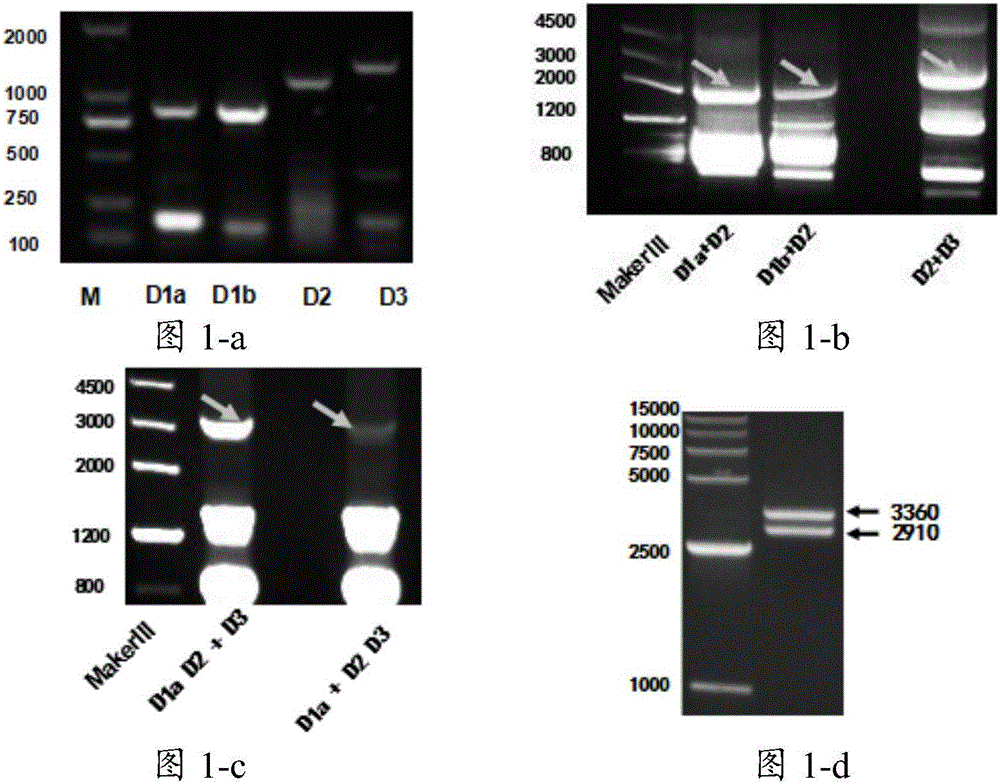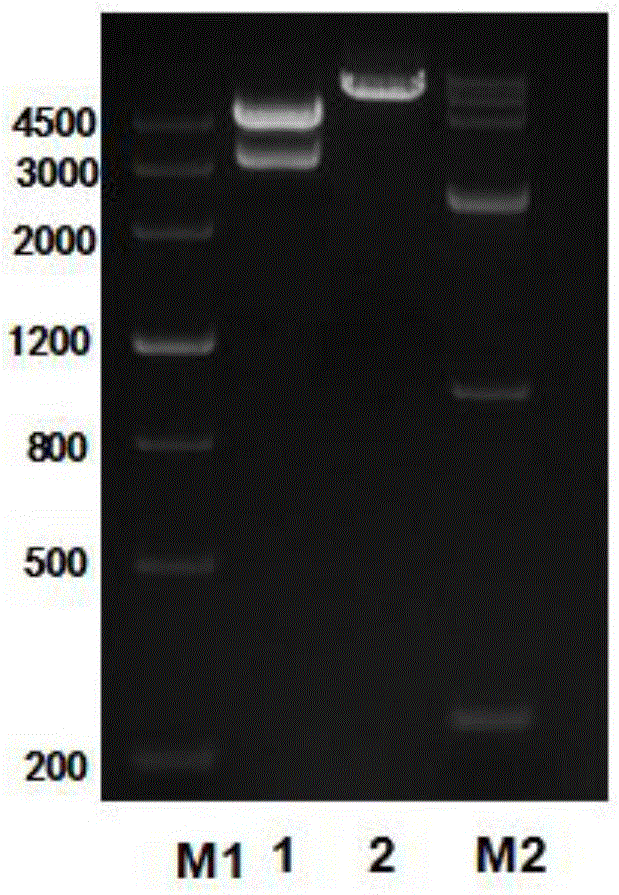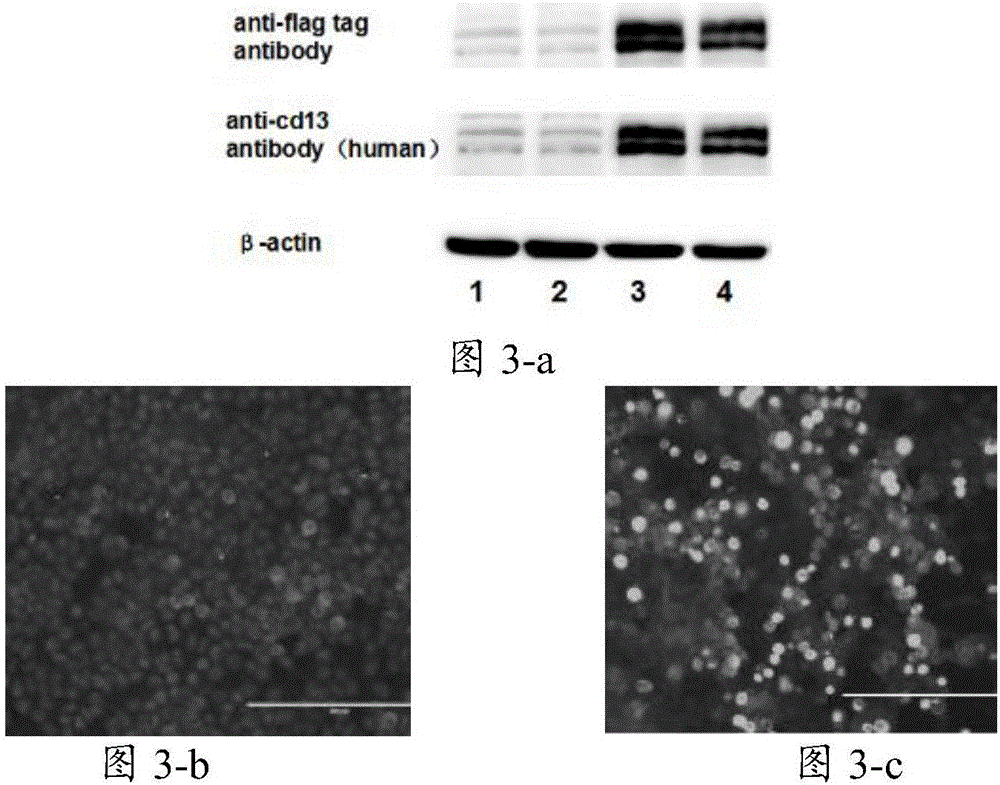An expression vector and a Vero cell line expressing pig aminopeptidase N
An expression vector, porcine aminopeptidase technology, applied in the field of bioengineering, can solve the problems of complex culture conditions, slow growth, and biosafety needs to be evaluated, and achieves high efficiency and promotes replication.
- Summary
- Abstract
- Description
- Claims
- Application Information
AI Technical Summary
Problems solved by technology
Method used
Image
Examples
Embodiment 1
[0054] Example 1 Construction of pAPN eukaryotic overexpression plasmid
[0055] The eukaryotic overexpression plasmid of pAPN uses pcDNA3.1(+)-puro as the vector plasmid. In order to facilitate the detection of the overexpression of pAPN at the protein level in the later stage, a flag-tag tag is added to its N end through a primer. The build process is as follows:
[0056] 1 material
[0057] Porcine small intestine tissue and pcDNA3.1(+) plasmid are kept in this laboratory
[0058] 2 test process
[0059] 1. Construct pcDNA3.1(+)-puro plasmid
[0060] Obtain the puro resistance gene. The sequence of the puro resistance gene is shown in SEQ ID NO: 2. The puro resistance gene fragment is ligated into pcDNA3.1(+) plasmid with restriction enzyme cut sites Sma I and Sal I. pcDNA3.1(+)-puro plasmid.
[0061] 2. Obtain the CDS sequence (SEQ ID NO:1) of pAPN gene
[0062] Since the full length of the mRNA encoding pAPN is 3387bp, the CDS sequence of the complete porcine aminopeptidase N is 289...
Embodiment 2
[0087] Example 2 Screening of Vero cell lines stably expressing pAPN
[0088] 1 material
[0089] The pcDNA3.1(+)-puro-pAPN-flag-N plasmid constructed in Example 1, and the Vero cell line was purchased from the cell bank of the Type Culture Collection Committee of the Chinese Academy of Sciences;
[0090] 2 test process
[0091] 1) Plasmid linearization
[0092] Use pvu I to digest pcDNA3.1(+)-puro-pAPN-flag-N to linearize the plasmid without affecting the expression of pAPN. The linearized plasmid obtained was ethanol-precipitated and then autoclaved with ddH 2 After O is dissolved, measure the concentration for later use. The result of plasmid linearization is as follows figure 2 Shown.
[0093] 2), liposome transfection
[0094] Use the linearized expression plasmid obtained in the previous step 3000 reagent transfection Vero cell line, please refer to Invitrogen for steps TM company's 3000 kit. After transfection, place at 37℃, 5% CO 2 Cultivate for 48h, and screen the clones ...
Embodiment 3
[0108] Example 3: PEDV challenge test to verify the proliferation effect of Vero cell line overexpressing pAPN on PEDV
[0109] 1 material
[0110] The Vero cell line was purchased from the cell bank of the Type Culture Collection Committee of the Chinese Academy of Sciences; Vero-11 was the Vero cell line that was able to stably overexpress pAPN screened in Example 2; the PEDV vaccine virus was a gift from Jilin Zhengye Biochemical Technology Company;
[0111] 2 test process
[0112] The Vero blank control cells and the identified pAPN overexpression positive clonal cell line Vero-11, respectively, according to 1.5×10 6 The density of cells / well is plated in a 6cm plate. After 8 hours, the cell confluence rate is about 70% to 80%. The PEDV virus is inoculated into the corresponding cells at an MOI of 0.1. After 48 hours, the virus cells and RNA in the supernatant and inverted to cDNA. Use TRNzol A directly for RNA in cells + Reagent extraction. Extract RNA from the supernatant, pip...
PUM
 Login to View More
Login to View More Abstract
Description
Claims
Application Information
 Login to View More
Login to View More - R&D
- Intellectual Property
- Life Sciences
- Materials
- Tech Scout
- Unparalleled Data Quality
- Higher Quality Content
- 60% Fewer Hallucinations
Browse by: Latest US Patents, China's latest patents, Technical Efficacy Thesaurus, Application Domain, Technology Topic, Popular Technical Reports.
© 2025 PatSnap. All rights reserved.Legal|Privacy policy|Modern Slavery Act Transparency Statement|Sitemap|About US| Contact US: help@patsnap.com



